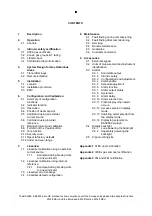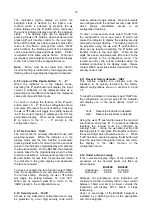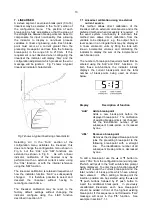
5
3.3 4/20mA input
The input safety parameters for the 4/20mA input,
terminals 1 and 3 are:
Ui
=
30V dc
Ii
=
200mA
Pi
=
0.84W
The maximum equivalent capacitance and
inductance between the two 4/20mA input
terminals 1 and 3 is:
Ci
= 13nF
Li
= 16µH
The maximum permitted loop cable parameters
can be calculated by adding these figures to Ci and
Li of other instruments in the loop and subtracting
the totals from the maximum cable capacitance Co
and cable inductance Lo permitted for the Zener
barrier or galvanic isolator powering the loop.
Although the indicators do not themselves comply
with the requirements for
simple
apparatus
, the
EC-Type Examination Certificate states that for
intrinsic safety considerations, under fault
conditions the output voltage, current and power at
terminals 1 & 3 will not exceed those specified by
clause 5.7 of EN 60079-11 for
simple apparatus.
This simplifies the application and intrinsic safety
documentation for a loop into which an indicator is
connected. Apart from Ci, the effect of the
indicator may be ignored when assessing loop
safety.
3.4 Certification label information
The certification label is fitted in a recess on the
top outer surface of the instrument enclosure. It
shows the ATEX certification information and BEKA
associates' name and location. Non European
certification information may also be shown. The
instrument serial number and date of manufacturer
are recorded on a separate label inside the
terminal compartment.
BA304E certification label
BA324E certification label
4.
SYSTEM DESIGN FOR GAS HAZARDOUS
AREAS
4.1 Transmitter loops
Both models may be connected in series with
almost any intrinsically safe 4/20mA current loop
and calibrated to display the measured variable or
control signal in engineering units. There are
three basic design requirements:
1. The intrinsic safety output parameters of the
4/20mA loop, which are defined by the Zener
barrier or galvanic isolator powering the loop,
must be equal to or less than:
Uo
=
30V dc
Io
=
200mA
Po
=
0.84W
2. The maximum permitted cable capacitance
of the loop must be reduced by 13nF. The
maximum permitted cable inductance is not
reduced by the inclusion of the indicator.
3. The loop must be able to tolerate the
additional 1.2V required to operate the
indicator. When fitted with an optional
backlight this increases to 5.0V if the
backlight is loop powered. See 9.4.1
Figs 2a and 2b illustrate typical applications in
which an indicator is connected in series with a
2-wire transmitter powered by a Zener barrier and
alternatively by a galvanic isolator.
Fig 2a Loop powered by a Zener barrier
Fig 2b Loop powered by a galvanic isolator






































